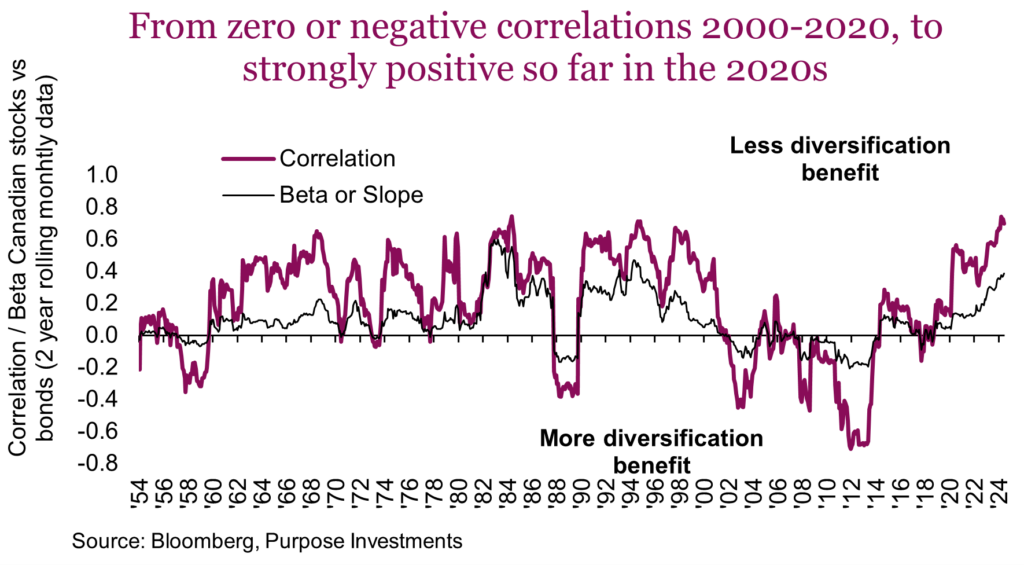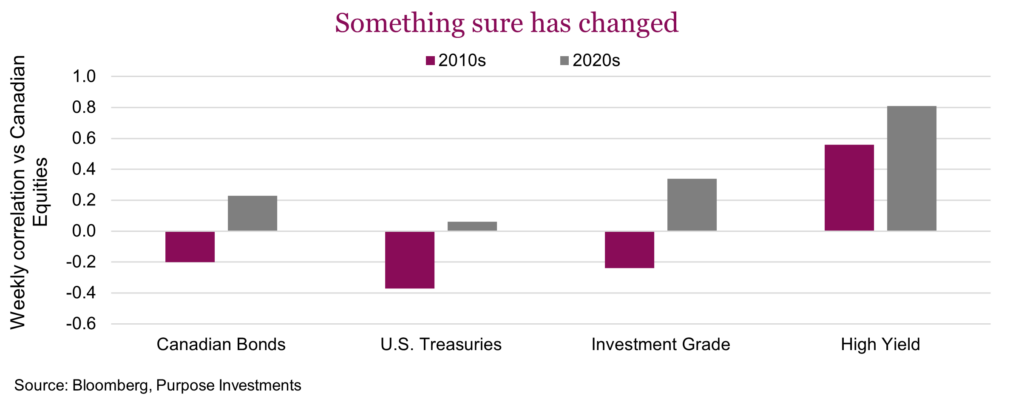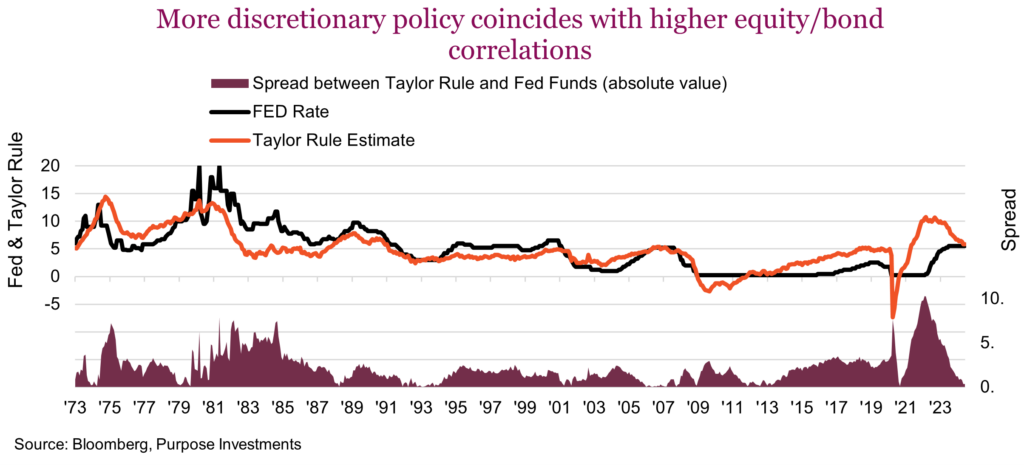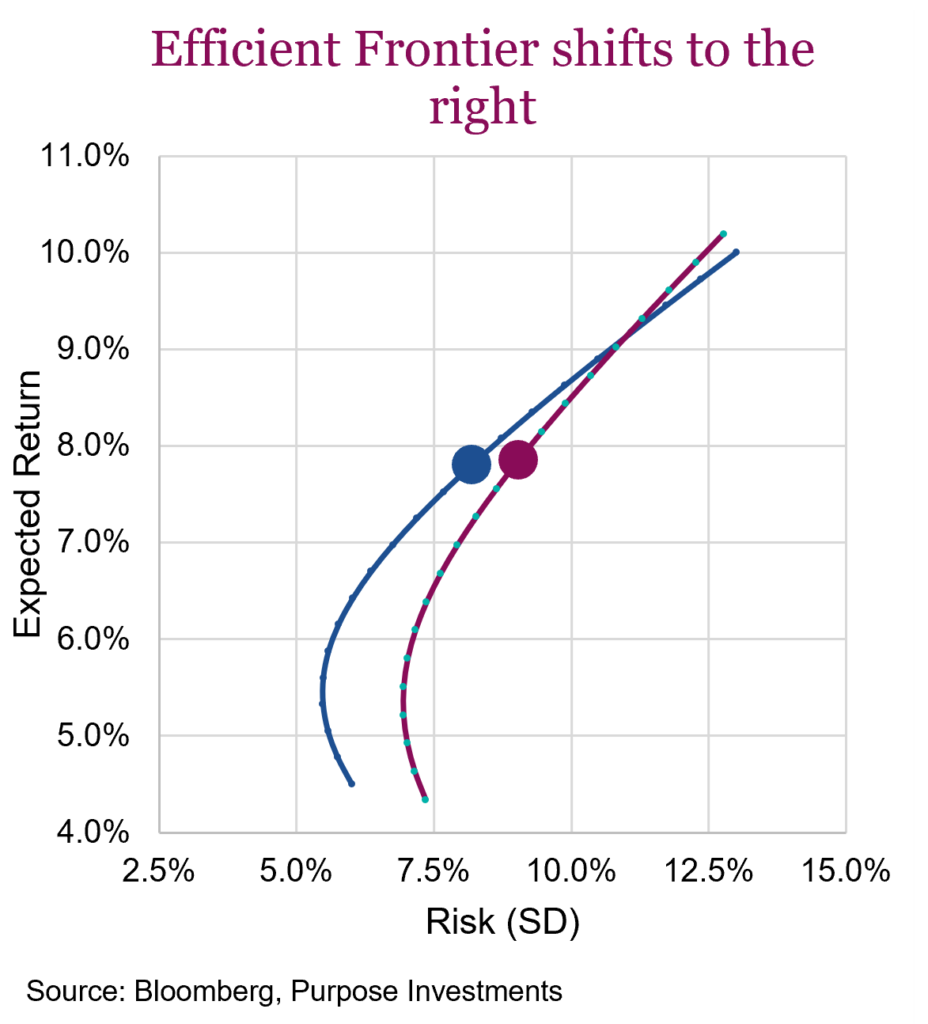Market Ethos
July 8, 2024
Bonds-equities: Diversification is harder to come by
Sign up here to receive the Market Ethos by email.
Remember the days when stocks and bonds moved more independently or even in the opposite direction to one another? Ahhhh, the 2010s – with the benefit of hindsight, it really was a marvelous time. Global equities annualized a little over 10%, and while bonds provided a paltry 3-4%, they were consistently negatively correlated, especially during periods of market stress. Folks got very used to the returns coming from the equity side of the portfolio, while the bond side provided meagre returns and acted as a stabilizer.
This is no longer the 2010s. Since the pandemic-induced bottom in bond yields, the 2020s have seen a dramatic move higher in correlations between equities and bonds – not just in the correlation of returns but also in the magnitude. Global equities to global bonds have had a 0.5 positive correlation (weekly) since 2020 compared to 0.05 from 2010-2019. The chart below also highlights this change, using Canadian equities and Canadian bonds back to the 1950s.

It is not just a Canadian phenomenon; pick just about any category in bonds around the world, and correlations have increased. The chart below shows weekly correlations of various bond and equity indices compared to the TSX. This looks very similar if you pick the S&P or global equities. There has also been a small uptick in correlations between equity markets, but we will save that for another Market Ethos. The crux of it is that equity/bond correlations are higher.
For building and managing portfolios, this raises a few very important questions:
- Is the positive equity/bond correlation temporary and caused by the pandemic, or will it persist?
- What does it mean for investor expectations?
- Should it impact how portfolios are constructed? [topic for future Ethos, not this one]

Positive correlations – temporary or permanent?
There are some pretty good arguments on both sides. The pandemic triggered many changes and reverberations that are still impacting markets and economies. This has negated or called into question many investment rules of thumb that have worked for decades. Could the equity/bond correlation just be another one that will eventually “go back to normal”? Maybe.
When bond yields were below 1% in 2020, we all knew they had to go higher at some point. We all knew that when central banks had reduced overnight rates to around zero, they had to go up at some point. The pandemic and subsequent inflation paved the way for rates/yields to rise, creating a sort of reset to more normal rates. This has certainly been an odd scenario, which would support the view that this heightened period of correlations may be temporary.
Yet we all suffer from recency bias, recalling more recent events and giving them greater weighting in our lens of the world. In this case, investors likely place too much emphasis on the 2010s. This was a unique period coming out of a recession that was driven by a credit crisis. Credit-driven recessions, which are rare, are typically followed by an extended period of low economic growth and benign inflation because balance sheets are often being repaired. With no inflation, both the bond and equity markets took more of their cues from the trajectory of economic growth. If improving, stocks will go up and bonds will go down. If slowing, then the opposite will happen. Hence, there is a period of negative equity/bond correlations.
The 2010s were likely the outlier. As can be seen in the first chart, equities and bonds often carry a positive correlation. Maybe it’s a little too elevated of late, but it’s really closer to the 70-year average today than in the previous decade.
Inflation and the economy – Equity bond correlations tend to run higher when inflation is elevated. At the same time, correlations are often lower when economic growth is lower. So, in the recent couple of years, it shouldn’t be too much of a surprise that correlations are high given pretty robust economic growth (in real terms) and higher inflation.
Once again, a recession may cure many of the odd relationships that exist in the market today. Given current yields in the bond market, one would expect yields to fall if economic growth begins to falter. Falling yields equal higher bond prices, which would likely be negative for equity markets; it is the prospects of earnings growth that are crucial for the market to support current valuations.
Monetary policy – In the 1970s and early 1980s, monetary policy was much more discretionary rather than rules-based. To measure this, we use the Taylor Rule to determine the Fed Funds rate compared to the actual Fed Funds rate. The greater the spread, the more central banks are behaving with greater discretion. From the late 1980s until 2020, the spread between the Taylor Rule and Fed Funds was much narrower and more stable. That all changed in 2020 as policy was enacted to combat the economic impact of the pandemic. But few would disagree that the monetary policy was at odds with reality as the economy recovered relatively quickly and stimulus was left super accommodative.
Greater discretion in setting overnight rates in the 1970s and early 1980s, then again since 2020 likely causes bonds to react more to monetary policy than economic growth. When that occurs, equity/bond correlations have tended to be higher.

We do not believe equity/bond correlations will remain as high as they have been over the past couple of years. However, we also do not believe we are returning to the 2000-2020 environment of near zero or even periods of negative correlations. We are likely in a world where things remain more correlated than in recent history.
What does this mean for investor expectations?
Obviously, with a higher correlation, bonds’ defensive attributes are being called into question. Yet the expected return has also risen substantially. Generally, the current available yield is a very good proxy for bond return expectations. So bonds probably don’t get an A+ anymore as a portfolio stabilizer. The silver lining is that with higher yields, bonds now offer a more constructive return expectation profile.
Holding equity expected return and volatility constant, what happens if bonds enjoy a slightly higher expected return with higher volatility and a higher correlation to equities? Well, the efficient frontier shifts to the right for most equity/bond combinations. The 100% equity end point remains anchored for both. Since most portfolios are somewhere along the curve, we added larger circles for the often-referred to 60/40 mix.
Focusing on the 60/40, the expected return is a bit higher thanks to slightly more of a contribution from the bond 40. But the risk has also increased much more.

In a more correlated world, diversification becomes harder to come by, and as a result, portfolios are likely going to be more volatile. This is already evident. A 60% equity (25% Canadian equity, 35% global equities) and 40% Canadian bond portfolio has experienced a 3-year annualized standard deviation (risk) of about 10% during the past few years. For the 2010s, once the 2008 bear market dropped off, risk averaged about 6% for years.
Investors have not minded this greater volatility too much, given that markets are making new highs. Still, this mood will change quickly if equity markets falter and bonds remain positively correlated, not coming to the portfolio’s rescue as they did in years past.
Final thoughts
Equity/bond correlations have turned positive, and this is reducing the benefit of diversification. Thanks to higher yields, the higher expected bond return provides some solace. But if this higher correlation world is the new norm, investors should expect greater volatility for the same return as experienced in decades past. Bonds still work, just not as they did in the 2010s. They’re not as defensive but they have some better return potential. Bonds would likely really start to work well again should we enter some sort of recessionary environment. Let’s not hope for that, though.
In the meantime, diversification has become harder to come by in a more correlated world. In one of our next Ethos later this month, we will dive into portfolio construction implications.



